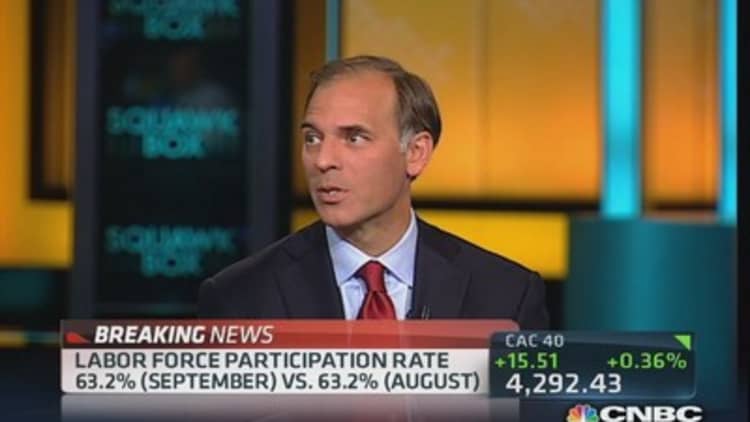The Fed is expected to keep easing at full throttle well into next year, after September's tepid jobs report showed the impact of a painfully slow growing economy on employment.
The economy added 148,000 nonfarm payrolls, compared with expectations for 180,000, and a revised 193,000 in August. The jobless rate fell to 7.2 percent, from 7.3 percent.
The report, delayed by the government shutdown and released Tuesday morning, showed surprisingly low growth in the private sector of just 129,000 jobs and a weakening trend in the past several months. While August jobs were revised to 193,000 from 169,000, the July report was revised down to 89,000 from 104,000.
The report reflects an economy stuck in low gear, an environment likely to keep the Fed from slowing its $85 billion in monthly bond purchases any time soon. The Fed had been expected to begin to taper bond purchases this fall, but after the government shut down, Fed watchers moved their expectations to December at the earliest.

Stocks firmed and Treasurys were bid as traders bet the report indicated a longer period of Fed easing. The moved further into record territory, higher for a fourth day. The dollar weakened against a basket of currencies.
"There's good and bad in this report. I think it's good to see full-time employment was up and part-time was down," said John Canally, investment strategist and economist at LPL Financial. "The participation rate stabilized. That's a positive, and state and local governments have stabilized and added jobs in the last two months. It's less layoffs. ... They're not hiring. They just stopped firing."
(Read more: Why the Fed won't be easing anytime soon)
"I think they're (Fed officials) firmly on hold. It won't be until March before they have another window. There's the fog of the data," said Mark Zandi, chief economist at Moody's Analytics. "It feels like the economy weakened this summer, and given the shutdown and the brinkmanship, it will weaken further going into next year."
The Fed surprised the markets when it did not announce a tapering of its bond program after its September meeting, as expected. At the time, the Fed pointed to financial conditions and fiscal headwinds.
The September employment data also came ahead of the 16-day government shutdown, which started Oct. 1, and did not reflect its economic impact. The jobs report, originally scheduled for an Oct. 4 release, had been anticipated as the most important piece of data for the Fed to review at its meeting next Tuesday and Wednesday, but now it is viewed as stale even though it reflects a trend of weakening.
"It does reinforce the next year (Fed) timeline, but any one data point doesn't really matter. What matters is that job creation has slowed each quarter this year," said Dan Greenhaus, chief global strategist at BTIG.
(Watch this: Bob Pisani talks about Fed tapering)
Greenhaus noted that monthly job creation was just 143,000 in the third quarter, after an average 207,000 jobs were created in the first quarter, and 182,000 were added in the second quarter. "Despite calls for a pickup in growth and job creation that have been in place for several quarters now, we expected the future to look like the past. Absent a change in ... something, we fail to see why things should look meaningful different in the near future," he wrote in a quick commentary.
Economists expect it to be several months before the employment data give a clear signal of what is happening, due to the ripple effect of private sector workers furloughed because of the government shutdown.
"Odds are high that job growth will continue to soften over the next few months," said Zandi. "It's going to be hard to know, given the quality of the data we'll get. The October number is going to be weak by definition."
Congress ended the shutdown last week by approving legislation that kicked the budget decision into January and the debt ceiling deadline into February.
"October could be closer to 100,000 and November could be closer to 200,000, and the question is what's the reality? And then by December we're going to be in the midst of the next round of the budget battle," said Zandi.
Economists believe the shutdown shaved about a half percent off fourth quarter growth. A raft of government data for October has been delayed by the shutdown, so the fourth quarter picture has become even murkier than normal. The September jobs report shows second half growth was already slow.
"It reflects slower economic growth. The GDP numbers have been weak. Year-over-year through Q2 was 1.5 percent and Q3 was tracking well below 2 percent. The economy is growing less than 2 percent, and that's more consistent with 150,000 jobs a month, rather than 200,000 jobs a month," Zandi said.
Zandi said he expects growth would pick up if partisan budget battling were to stop, but there are other factors. "I think it just confirms that the jobs market softened considerably this summer, and the most likely culprit is tax increases and spending cuts," he said, adding there could be some impact from employer reaction to the Affordable Care Act.
In September, the manufacturing sector added just 2,000 jobs, while there was a silver lining in the addition of 20,000 construction jobs. Retail added about 20,000, but there was a reduction of 13,000 leisure industry jobs. On the plus side, there was an addition of 22,000 government payrolls from state and local governments.
The length of the work week was steady at 34.5 hours and average hourly earnings increased by three cents in September.
—By CNBC's Patti Domm. Follow her on Twitter @pattidomm


